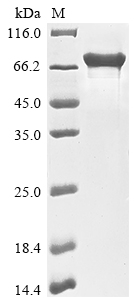YTHDF1, a member of the YTH domain family, is an m6A reader protein that plays a crucial role in various cancers, including non-small cell lung cancer (NSCLC), colorectal carcinoma, hepatocellular carcinoma, and gastric tumors. It has been found to promote tumor progression, metastasis, and cancer stem cell-like activity [1][2]. YTHDF1 is involved in regulating mRNA stability and facilitating translation initiation by interacting with initiation factors and ribosomes [3][4]. Additionally, it has been linked to the activation of the PI3K/AKT/mTOR signaling pathway and the induction of epithelial-mesenchymal transition in hepatocellular carcinoma [2]. Furthermore, YTHDF1 has been associated with better patient survival and an inflamed tumor-immune microenvironment in NSCLC, indicating its potential as a prognostic biomarker [3][5]. Studies have also suggested that YTHDF1 may inhibit the growth of neuroblastoma and restore sensitivity to antitumor immunity in gastric tumors [6][7]. Moreover, YTHDF1 has been implicated in promoting cancer progression by regulating ferritin-mediated ferroptosis in lung carcinoma [4]. However, the molecular mechanisms through which YTHDF1 exerts its functions and its regulation remain areas of active research [8][9]. Overall, YTHDF1 emerges as a potential therapeutic target and prognostic biomarker in cancer, with its multifaceted roles in tumorigenesis and tumor progression.
References:
[1] Y. Bai, C. Yang, R. Wu, L. Huang, S. Song, W. Liet al., "Ythdf1 regulates tumorigenicity and cancer stem cell-like activity in human colorectal carcinoma", Frontiers in Oncology, vol. 9, 2019. https://doi.org/10.3389/fonc.2019.00332
[2] X. Luo, M. Cao, F. Gao, & X. He, "Ythdf1 promotes hepatocellular carcinoma progression via activating pi3k/akt/mtor signaling pathway and inducing epithelial-mesenchymal transition", Experimental Hematology and Oncology, vol. 10, no. 1, 2021. https://doi.org/10.1186/s40164-021-00227-0
[3] K. Tsuchiya, K. Yoshimura, Y. Inoue, Y. Iwashita, H. Yamada, A. Kawaseet al., "Ythdf1 and ythdf2 are associated with better patient survival and an inflamed tumor-immune microenvironment in non–small-cell lung cancer", Oncoimmunology, vol. 10, no. 1, 2021. https://doi.org/10.1080/2162402x.2021.1962656
[4] H. Diao, H. Tan, Y. Hu, R. Wang, P. Cai, B. Huanget al., "The m6a reader ythdf1 promotes lung carcinoma progression via regulating ferritin mediate ferroptosis in an m6a-dependent manner", Pharmaceuticals, vol. 16, no. 2, p. 185, 2023. https://doi.org/10.3390/ph16020185
[5] J. Hu, D. Qiu, A. Yu, J. Hu, H. Deng, H. Liet al., "Ythdf1 is a potential pan-cancer biomarker for prognosis and immunotherapy", Frontiers in Oncology, vol. 11, 2021. https://doi.org/10.3389/fonc.2021.607224
[6] J. Deng, J. Long, Y. Yang, & F. Yang, "M6a reader ythdf1 inhibits the growth of neuroblastoma in vitro and in vivo",, 2023. https://doi.org/10.21203/rs.3.rs-3166065/v1
[7] X. Bai, Y. Pan, H. Chen, W. Liu, J. Zhai, W. Kanget al., "Loss of ythdf1 in gastric tumors restores sensitivity to antitumor immunity by recruiting mature dendritic cells", Journal for Immunotherapy of Cancer, vol. 10, no. 2, p. e003663, 2022. https://doi.org/10.1136/jitc-2021-003663
[8] J. Zhou, D. Xiao, T. Qiu, J. Li, & Z. Liu, "Loading microrna-376c in extracellular vesicles inhibits properties of non-small cell lung cancer cells by targeting ythdf1", Technology in Cancer Research & Treatment, vol. 19, p. 153303382097752, 2020. https://doi.org/10.1177/1533033820977525
[9] Y. Shi, S. Fan, M. Wu, Z. Zuo, X. Li, L. Jianget al., "Ythdf1 links hypoxia adaptation and non-small cell lung cancer progression", Nature Communications, vol. 10, no. 1, 2019. https://doi.org/10.1038/s41467-019-12801-6




